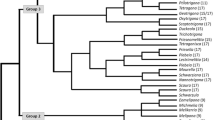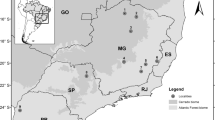Abstract
A survey of chromosome polymorphism was made in populations of Pheidole nodus (Hymenoptera, Formicidae). A total of 1,666 males were collected from 11 localities in Japn. Four polymorphic karyotypes were observed: (1) n = 17 with 4 metacentrics (abbreviated as 4M), (2) n = 18(3M), (3) n = 19(2M) and (4) n = 20(1M). These differences are due to the Robertsonian type rearrangement. The karyotype 18(3M) is found in all the populations examined, but the others are more or less localized in their distribution. The 17(4M) appears mainly in Shikoku and the northern Kyushu populations, 19(2M) along the Pacific coast of Honshu, Shikoku and Kyushu, and 20(1M) in the eastern part of Honshu and Shikoku. This distribution pattern indicates that 18(3M) is the oldest, 19(2M) and 20(1M) are derived from 18(3M) by centric fission, and 17(4M) by centric fusion. The most probable mechanism of karyotype evolution in this species is considered to be the centric fission.
Similar content being viewed by others
References
Crozier, R. H.: Chromosome number polymorphism in an Australian ponerine ant. Canad. J. Genet. Cytol. 11, 333–339 (1969)
Darlington, C. D., LaCour, L. F.: Hybridity selection in Campanula. Heredity 4, 217–248 (1950)
Hewitt, G. M.: The integration of supernumerary chromosomes into the orthopteran genome. Cold Spr. Harb. Symp. quant. Biol. 38, 183–194 (1973)
Imai, H. T.: B-chromosomes in the myrmicine ant, Leptothorax spinosior. Chromosoma (Berl.) 45, 431–444 (1974)
Imai, H. T.: Evidence for non-random localization of the centromere on mammalian chromosomes. J. theor. Biol. 49, 111–123 (1975)
Imai, H. T., Kubota, M.: Karyological studies of Japanese ants (Hymenoptera, Formicidae). III. Chromosoma (Berl.) 37, 193–200 (1972)
John, B., Hewitt, G. M.: Karyotype stability and DNA variability in the Acrididae. Chromosoma (Berl.) 20, 155–172 (1966)
John, B., Hewitt, G. M.: Patterns and pathways of chromosome evolution within the Orthoptera. Chromosoma (Berl.) 25, 40–74 (1968)
Kato, H., Sagai, T., Yosida, T. H.: Stable telocentric chromosomes produced by centric fission in chinese hamster cells in vitro. Chromosoma (Berl.) 40, 183–192 (1973)
Lima-de-Faria, A.: The role of the kinetochore in chromosome organization. Hereditas (Lund) 42, 85–160 (1956)
Lindsley, D. N., Grell, E. H.: Genetic variations of Drosophila melanogaster. Carnegie Inst. Wash. Publ. 627 (1968)
Malécot, G.: Les mathématiques de l'hérédité. Paris: Masson et Cie. 1948
Mark, G. E.: Telocentric chromosomes. Amer. Naturalist 91, 223–232 (1957)
Matthey, R.: Cytologie comparée et polymorphisme chromosomique chez des Mus africains appartenant aux groupes bufo-triton et minutoides (Mammalia-Rodentia). Cytogenetics 2, 290–322 (1963)
McClintock, B.: The stability of broken ends of chromosomes in Zea mays. Genetics 26, 234–282 (1941)
Muller, H. J.: An analysis of the process of structural change in chromosomes of Drosophila. J. Genet. 40, 1–66 (1940)
Muller, H. J., Herskowitz, I. H.: Concerning the healing of chromosomes ends produced by breakage in Drosophila melanogaster. Amer. Naturalist 88, 177–208 (1954)
Olert, J.: A case of chromosome dissociation in a shrew. Genet. Res. (Camb.) 22, 323–324 (1973)
Rhoades, M. M.: Studies of a telocentric chromosome in maize with reference to the stability of its centromere. Genetics 25, 483–521 (1940)
Smith, F.: Description of new species of Tenthredinidae, Ichneumonidae, Chrysididae, Formicidae, &c. of Japan. Trans ent. Soc. Lond., pp. 373–409, 1874
Southern, D. I.: Stable telocentric chromosomes produced following centric misdivision in Myrmeleotettix maculatus (Thunb). Chromosoma (Berl.) 26, 140–147 (1969)
Strid, A.: Stable telocentric chromosomes formed by spontaneous misdivision in Nigella doerfleri (Ranunculaceae). Bot. Notiser 121, 153–164 (1968)
Takagi, N., Sasaki, M.: A phylogenetic study of bird karyotypes. Chromosoma (Berl.) 46, 91–120 (1974)
Todd, N. B.: Karyotype fissioning and canid phylogeny. J. theor. Biol. 26, 445–480 (1970)
Webster, T. P., Hall, W. P., Williams, E. E.: Fission in the evolution of a lizard karyotype. Science 177, 611–613 (1972)
White, M. J. D.: Animal cytology and evolution. 3rd ed. London: Cambridge University Press 1973
Wright, S.: Isolation by distance. Genetics 28, 114–138 (1943)
Yano, S.: Distribution of Pheidole nodus and Ph. fervida in Japan [In Japanese]. Konchū 2, 134–136 (1927)
Author information
Authors and Affiliations
Rights and permissions
About this article
Cite this article
Imai, H.T., Kubota, M. Chromosome polymorphism in the ant, Pheidole nodus . Chromosoma 51, 391–399 (1975). https://doi.org/10.1007/BF00326325
Received:
Accepted:
Issue Date:
DOI: https://doi.org/10.1007/BF00326325




